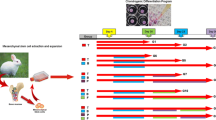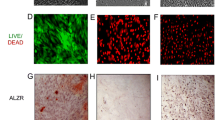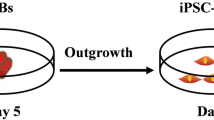Abstract
The purpose with this study was to investigate the effect of phenol red (PR) on chondrogenic and osteogenic differentiation of human mesenchymal stem cells (hMSCs). hMSCs were differentiated into chondrogenic and osteogenic directions in DMEM with and without PR for 2, 7, 14, 21, and 28 days. Gene expression of chondrogenic and osteogenic markers were analyzed by RT-qPCR. The presence of proteoglycans was visualized histologically. Osteogenic matrix deposition and mineralization were examined measuring the alkaline phophatase activity and calcium deposition. During chondrogenic differentiation PR decreased sox9, collagen type 2, aggrecan on day 14 and 21 (P < 0.05), and proteoglycan synthesis on day 21 and 28. Collagen type 10 was decreased on day 21 (P < 0.05). During osteogenic differentiation PR increased alkaline phosphatase on day 7 while decreased on day 21 (P < 0.05). PR increased collagen type 1 on day 7, 14, and day 21 (P < 0.05). The alkaline phosphatase activity was increased after 2, 7, and 14 days (P < 0.05). The deposition of calcium was decreased on day 21 (P < 0.05). Our results indicate that PR should be removed from the culture media when differentiating hMSCs into chondrogenic and osteogenic directions due to the effects on these differentiation pathways.







Similar content being viewed by others
References
Caplan, A. I. (2007). Adult mesenchymal stem cells for tissue engineering versus regenerative medicine. Journal of Cellular Physiology, 213, 341–347.
Caplan, A. I. (2005). Review: mesenchymal stem cells: cell-based reconstructive therapy in orthopedics. Tissue Engineering, 11, 1198–1211.
Jaiswal, N., Haynesworth, S. E., Caplan, A. I., & Bruder, S. P. (1997). Osteogenic differentiation of purified, culture-expanded human mesenchymal stem cells in vitro. Journal of Cellular Biochemistry, 64, 295–312.
Pytlik, R., Stehlik, D., Soukup, T., et al. (2009). The cultivation of human multipotent mesenchymal stromal cells in clinical grade medium for bone tissue engineering. Biomaterials, 30, 3415–3427.
Coelho, M. J., & Fernandes, M. H. (2000). Human bone cell cultures in biocompatibility testing. Part II: effect of ascorbic acid, beta-glycerophosphate and dexamethasone on osteoblastic differentiation. Biomaterials, 21, 1095–1102.
Coelho, M. J., Cabral, A. T., & Fernande, M. H. (2000). Human bone cell cultures in biocompatibility testing. Part I: osteoblastic differentiation of serially passaged human bone marrow cells cultured in alpha-MEM and in DMEM. Biomaterials, 21, 1087–1094.
Vater, C., Kasten, P., & Stiehler, M. (2011). Culture media for the differentiation of mesenchymal stromal cells. Acta Biomaterialia, 7, 463–477.
Nakamura, S., Yamada, Y., Baba, S., et al. (2008). Culture medium study of human mesenchymal stem cells for practical use of tissue engineering and regenerative medicine. Biomedical Materials and Engineering, 18, 129–136.
Berthois, Y., Katzenellenbogen, J. A., & Katzenellenbogen, B. S. (1986). Phenol red in tissue culture media is a weak estrogen: implications concerning the study of estrogen-responsive cells in culture. Proceedings of the National Academy of Sciences of the United States of America, 83, 2496–2500.
Still, K., Reading, L., & Scutt, A. (2003). Effects of phenol red on CFU-f differentiation and formation. Calcified Tissue International, 73, 173–179.
Myers, M. A. (1998). Direct measurement of cell numbers in microtitre plate cultures using the fluorescent dye SYBR green I. Journal of Immunological Methods, 212, 99–103.
Pfaffl, M. W., Tichopad, A., Prgomet, C., & Neuvians, T. P. (2004). Determination of stable housekeeping genes, differentially regulated target genes and sample integrity: bestKeeper–Excel-based tool using pair-wise correlations. Biotechnology Letters, 26, 509–515.
Bruder, S. P., Jaiswal, N., Ricalton, N. S., Mosca, J. D., Kraus, K. H., Kadiyala, S. (1998). Mesenchymal stem cells in osteobiology and applied bone regeneration. Clinical Orthopaedics and Related Research S247–256.
Ernst, M., Schmid, C., & Froesch, E. R. (1989). Phenol red mimics biological actions of estradiol: enhancement of osteoblast proliferation in vitro and of type I collagen gene expression in bone and uterus of rats in vivo. Journal of Steroid Biochemistry, 33, 907–914.
Ducy, P., Zhang, R., Geoffroy, V., Ridall, A. L., & Karsenty, G. (1997). Osf2/Cbfa1: a transcriptional activator of osteoblast differentiation. Cell, 89, 747–754.
Beresford, J. N., Joyner, C. J., Devlin, C., & Triffitt, J. T. (1994). The effects of dexamethasone and 1,25-dihydroxyvitamin D3 on osteogenic differentiation of human marrow stromal cells in vitro. Archives of Oral Biology, 39, 941–947.
van Driel, M., Koedam, M., Buurman, C. J., et al. (2006). Evidence that both 1alpha,25-dihydroxyvitamin D3 and 24-hydroxylated D3 enhance human osteoblast differentiation and mineralization. Journal of Cellular Biochemistry, 99, 922–935.
Viereck, V., Siggelkow, H., Tauber, S., Raddatz, D., Schutze, N., & Hufner, M. (2002). Differential regulation of Cbfa1/Runx2 and osteocalcin gene expression by vitamin-D3, dexamethasone, and local growth factors in primary human osteoblasts. Journal of Cellular Biochemistry, 86, 348–356.
Maehata, Y., Takamizawa, S., Ozawa, S., et al. (2006). Both direct and collagen-mediated signals are required for active vitamin D3-elicited differentiation of human osteoblastic cells: roles of osterix, an osteoblast-related transcription factor. Matrix Biology, 25, 47–58.
Nasatzky, E., Schwartz, Z., Boyan, B. D., Soskolne, W. A., & Ornoy, A. (1993). Sex-dependent effects of 17-beta-estradiol on chondrocyte differentiation in culture. Journal of Cellular Physiology, 154, 359–367.
Acknowledgements
This project was granted from the Velux Foundation and the A.P. Møller Foundation for the Advancement of Medical Science.
Disclosure of Potential Conflict of Interest
The authors declare no potential conflicts of interest.
Author information
Authors and Affiliations
Corresponding author
Electronic supplementary material
Below is the link to the electronic supplementary material.
Supplementary Fig. 1
DNA content after 2, 7, 14, and 21 days of osteogenic differentiation of hMSCs. Vertical axis represents the DNA content expressed by 700 nm channel intensity. Horizontal axis represents the medium type and time points. Data are expressed as mean ± SD (n = 12). (JPEG 19 kb)
Supplementary Fig. 2
DNA content and alkaline phosphatase activity after 2, 7, 14, and 21 days culture of hMSCs. Vertical axes represent DNA content expressed by 700 nm channel intensity and alkaline phosphatase activity expressed by nmol nitrophenol x ml−1 x min−1, respectively. Horizontal axes represent medium type and time points. Data are expressed as mean ± SD (n = 12). * Significant difference between DMEM wPR and DMEM woPR within the given time point, P < 0.05. (JPEG 40 kb)
Supplementary Fig. 3
Relative gene expression levels of runx2, alkaline phosphatase, collagen type 1, and osteocalcin after 2, 7, 14, and 21 days of osteogenic differentiation of hMSCs. Vertical axes represent the relative gene expression level and horizontal axes represent the medium type and time points. Data are expressed as mean ± SD (n = 6). * Significant difference between DMEM woPR + and DMEM woPR + D within the given time point, P < 0.05. Vitamin D significantly increased the gene expression of runx2 at all time points (P = 0.0000), alkaline phosphatase on day 2 and 7 (P = 0.0000), collagen type 1 at all time points (P = 0.000), and osteocalcin at all time points (P = 0.000) (Supplementary figure 3). On day 14, vitamin D significantly decreased the gene expression of alkaline phosphatase (P = 0.0019). (JPEG 82 kb)
Rights and permissions
About this article
Cite this article
Lysdahl, H., Baatrup, A., Nielsen, A.B. et al. Phenol Red Inhibits Chondrogenic Differentiation and Affects Osteogenic Differentiation of Human Mesenchymal Stem Cells in Vitro. Stem Cell Rev and Rep 9, 132–139 (2013). https://doi.org/10.1007/s12015-012-9417-0
Published:
Issue Date:
DOI: https://doi.org/10.1007/s12015-012-9417-0




